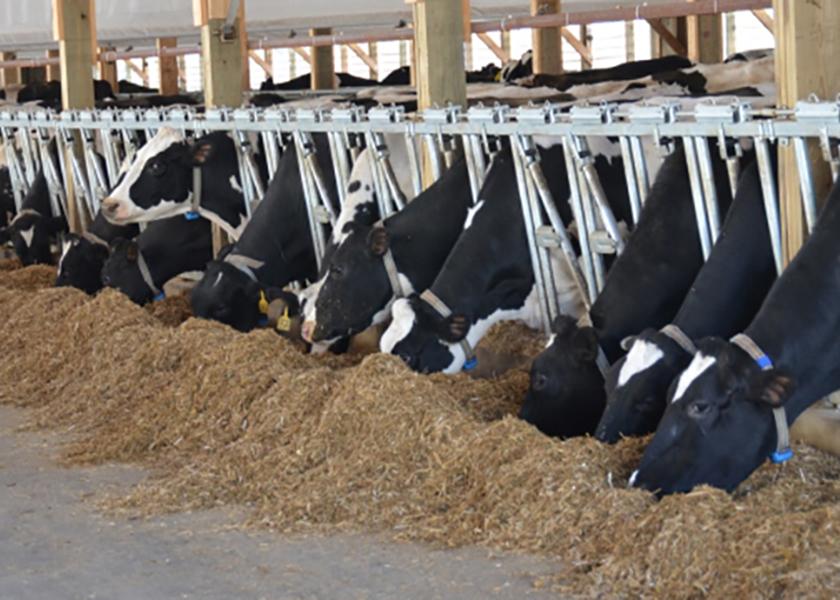Increasing Feed Efficiency

Dairy farmers have been confronted with sky rocketing concentrate prices in the last few months and forage prices will follow as the drought continues to effect larger portions of the U.S. These prices have put a lot of strain on dairy farmers and their herd’s nutritionist as they try to navigate shrinking margins.
The cost to feed a cow a day is a simple equation, the cost per pound of dry matter multiplied by the pounds that each cow (or group) eats. Subtract that number from the dollars of milk shipped per cow per day and you have your income over feed costs. If you want to lower feed costs you can look at lowering the cost per pound and the intakes. In some situations, it may make sense to try to lower both.
Cost per pound
The first thing to look at is your inventory. I consider contracted feed to be inventory because the price is controlled. On our farm, we have a bunch of $4 corn contracted but do not have any protein costs locked in, so we are reducing our lowest protein forage - corn silage, and increasing other higher protein forages like Italian rye grass and clover. We are using our cheap corn as a starch source and reducing our purchased protein needs. This ration has an added benefit of having higher NDFD and sugar levels. This allows us to reduce our overall starch levels in the diet.
In many areas of the country by-products will make more sense than forages. In these situations, effective fiber becomes very valuable. In these cases, we are using a lot of BMR Photo-Period-Sensitive [PPS] sorghum sudan. It is an excellent fiber producer, takes very little water, and is very cheap to grow. Because of its low water requirements, it allows us to plant more acres of it then we normally may have water for if we are using crops with higher water requirements like corn or alfalfa.
In areas with adequate water, we are trying to maximize acres of first year corn. First year corn is generally the easiest, most profitable crop we have because of its increased yields and lower input costs. In the upper Midwest and Northeast there is a great opportunity to plant shorter season silage corn after first crop. First crop hay generally yields 40%+ of the year’s hay yield. Taking it out a year early after 1st crop and maximizing corn acres may be a way to greatly improve profitability in the next 12 months.
Lower intakes
Some nutritionist are probably reading this and grimacing but I think lowering intakes is a huge opportunity to lower feed costs. Most nutritionists use NDFD30 as a metric for digestibility. This is the percentage of fiber that is digestible in 30 hrs. But how much fiber is actually in the cow for 30 hours? What if it is only in the rumen for 24 hrs. or 16 hrs.? BMR corn and alfalfa (with its very fragile fiber) exits the rumen rapidly. This can increase intakes because by exiting it makes room for more feed. This can also increase milk production, but it comes at a high cost. Farmers need to seriously look at whether the few extra pounds of milk is worth a 5-15% increase in feed intakes.
My hypothesis is that NDF limits intakes and that uNDF [undigestible fiber] further defines the NDF beyond its NDFD30. It has been well documented that cows have a limited amount of uNDF240 they can consume. The industry has lowered the percentage of NDF in the diets so that dairy cattle can eat more pounds of feed before hitting the uNDF limit. The uNDF limit can actually be used to our benefit. By using forages that have high amounts of NDF and low amounts of uNDF and at the same time high NDFD30 we are able to maintain production and lower ration costs. Forages like cool season grasses, immature small grains and warm season grasses like BMR millet and Sorghum Sudan can help us accomplish this. By just slightly slowing the rate of passage, we are increasing the extent of digestion. We are getting more value out of every pound of feed and our cows are making less manure.
With rising feed costs I think that should be our goal for this challenging year. There will be opportunities to be profitable if we are willing to be innovative and to look closely at our ration inputs and intakes.
Daniel Olson is a seventh-generation dairy farmer and the founder of Forage Innovations, a consulting company that brings innovative forage solutions to dairy farmers. They work with agronomists and nutritionists to develop forage systems that make farmers more profitable. Daniel can be reached at daniel@forageinnovations.guru







